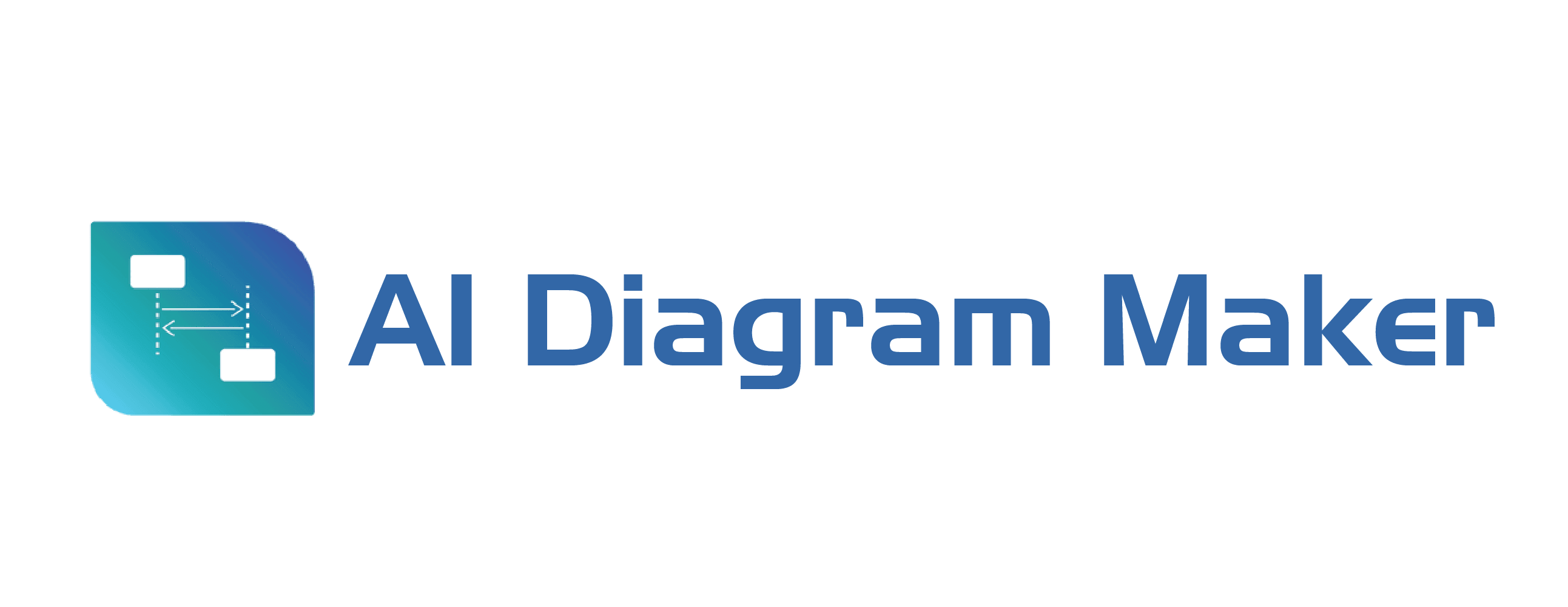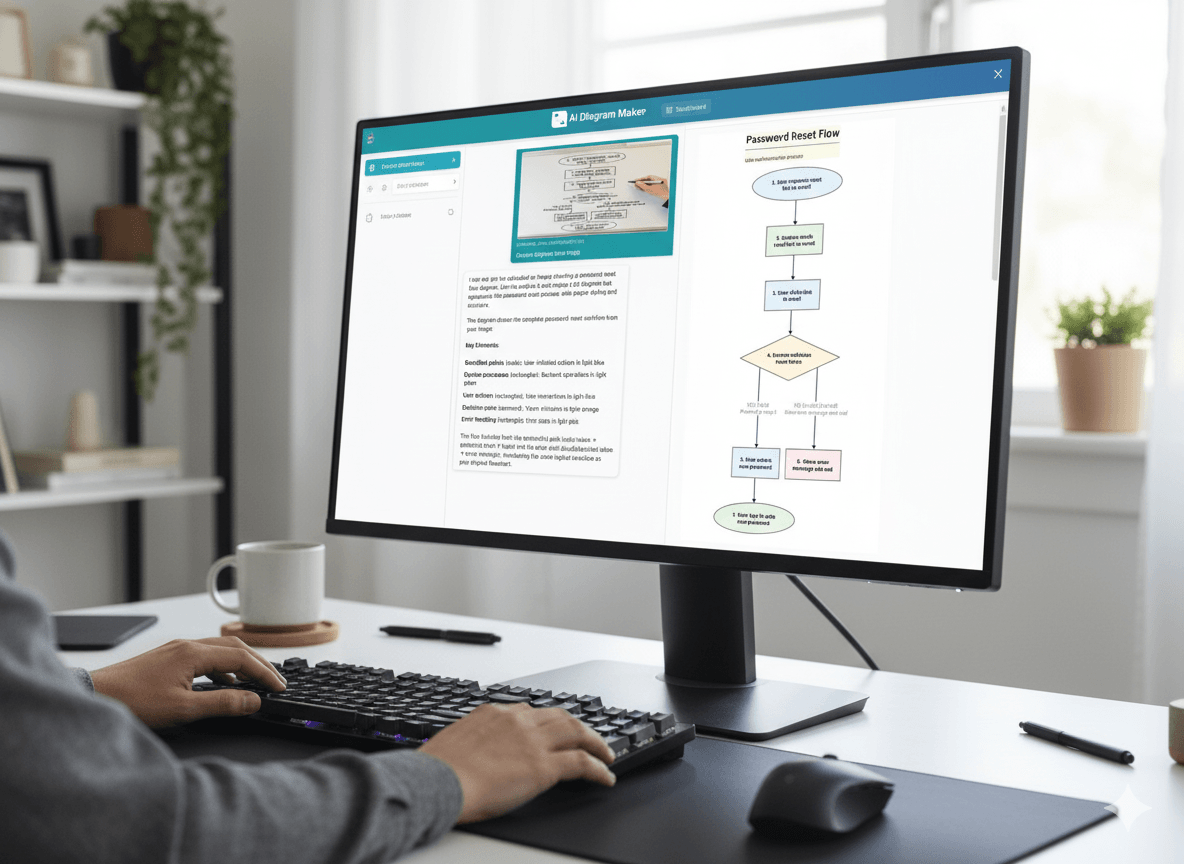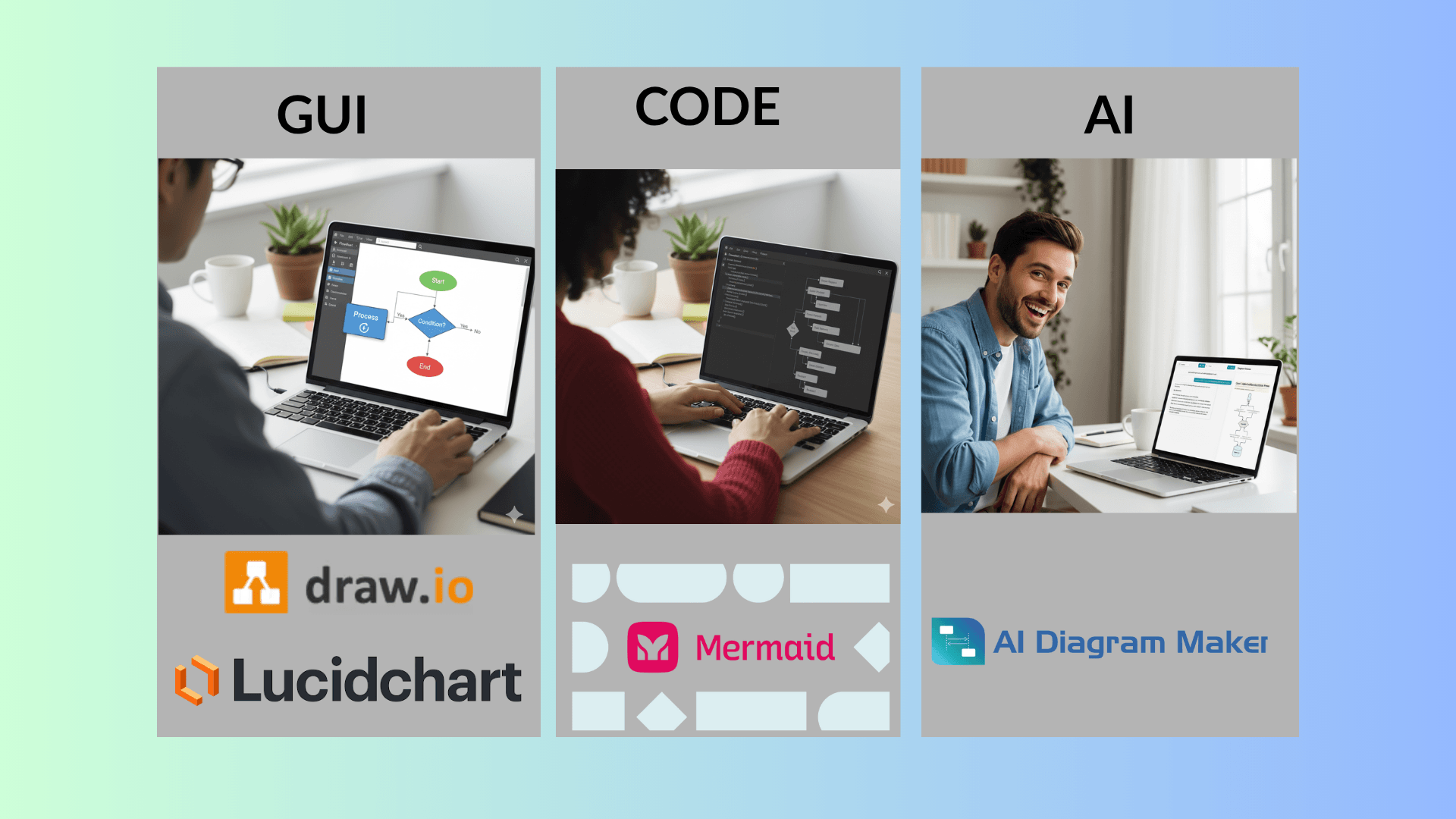· AI · 7 min read
AI UML Diagram Generator: Create Professional UML Diagrams from Text or Code
Generate professional UML class diagrams instantly with AI. Create UML diagrams from text descriptions or source code. Learn how AI UML diagram generators automate software design documentation and reverse engineering with text to diagram and code to diagram capabilities.

Creating UML diagrams manually is a time-consuming bottleneck in software development. Whether you’re designing a new system architecture or documenting existing code, drawing classes, defining relationships, and maintaining diagram accuracy takes valuable hours away from actual development work.
This guide demonstrates how AI UML diagram generators automate the entire process. We’ll show you how to create professional UML class diagrams from simple text descriptions and reverse engineer source code to diagrams—all in seconds instead of hours.
If you’d like to experiment with these concepts as you read, there’s a free AI UML diagram generator available that you can use to test the examples shown in this article.
Why UML Diagrams Matter
UML (Unified Modeling Language) class diagrams are essential for visualizing system architecture, onboarding developers, and maintaining documentation. They help identify design patterns early and support refactoring efforts with clear structural overviews.
The problem? Traditional UML tools require manual drawing and constant updates. AI-powered tools solve this by automating diagram creation from multiple input sources—text descriptions and source code.
How AI UML Diagram Generators Work
AI-powered tools use large language models to understand software structure and relationships from two input types:
- Text Descriptions: Analyzes requirements to identify classes, attributes, methods, and relationships (inheritance, composition, association), then generates diagram-as-code (D2, Mermaid, or PlantUML) and renders a professional UML diagram
- Source Code: Parses class definitions, method signatures, and inheritance hierarchies to extract structure, then maps relationships to generate an accurate UML class diagram
Practical Examples: Creating UML Diagrams with AI
Example 1: High-Level Prompt to UML Diagram
When you’re starting from scratch with just a design pattern concept, AI can transform a simple prompt into a complete, professional diagram.
Input: Simple high-level request for a Strategy pattern implementation
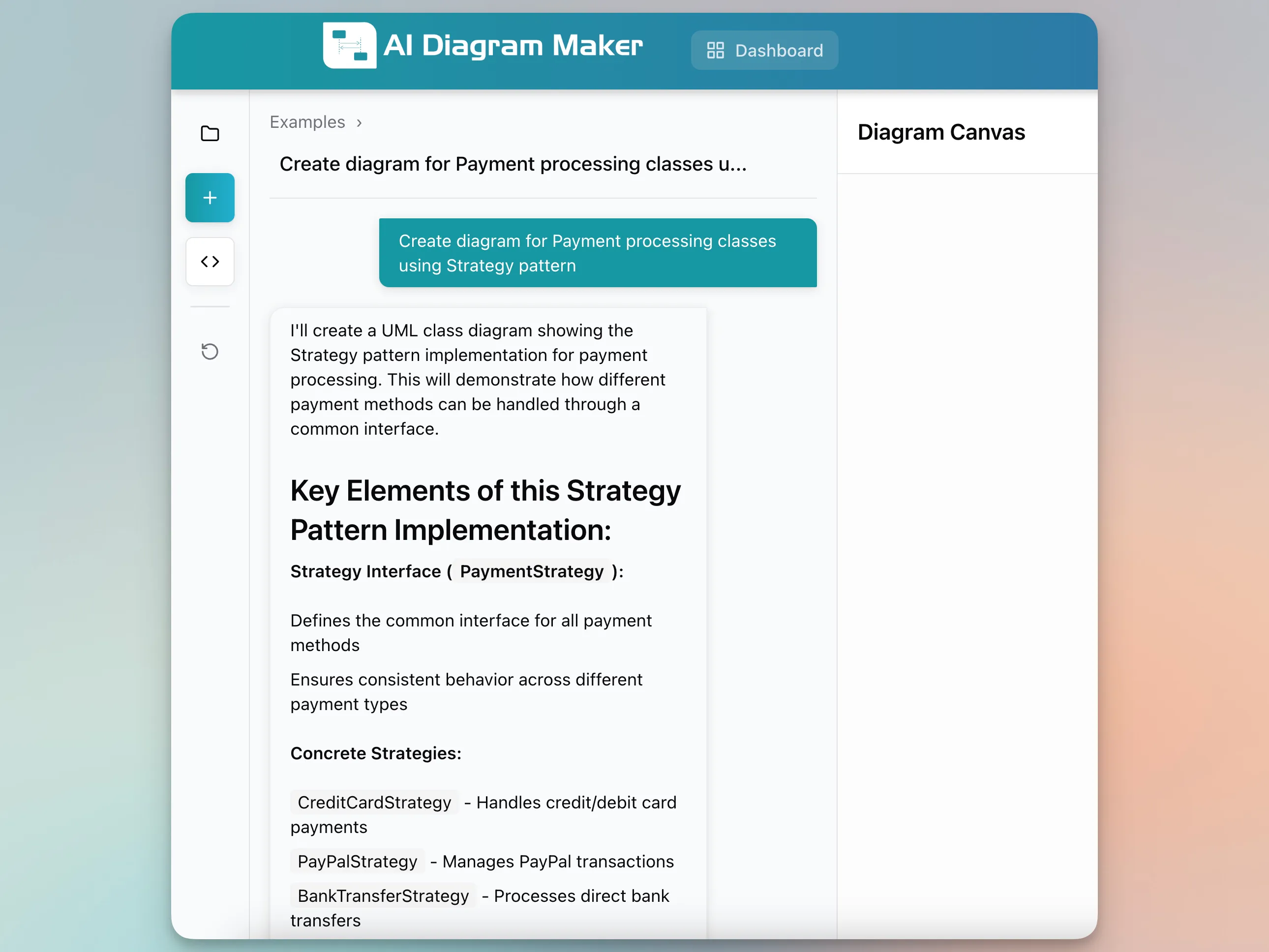
In this example, the user provided a concise prompt: “Create diagram for Payment processing classes using Strategy pattern.” The AI understood the request and generated a detailed explanation of the Strategy pattern implementation
The AI then generated:
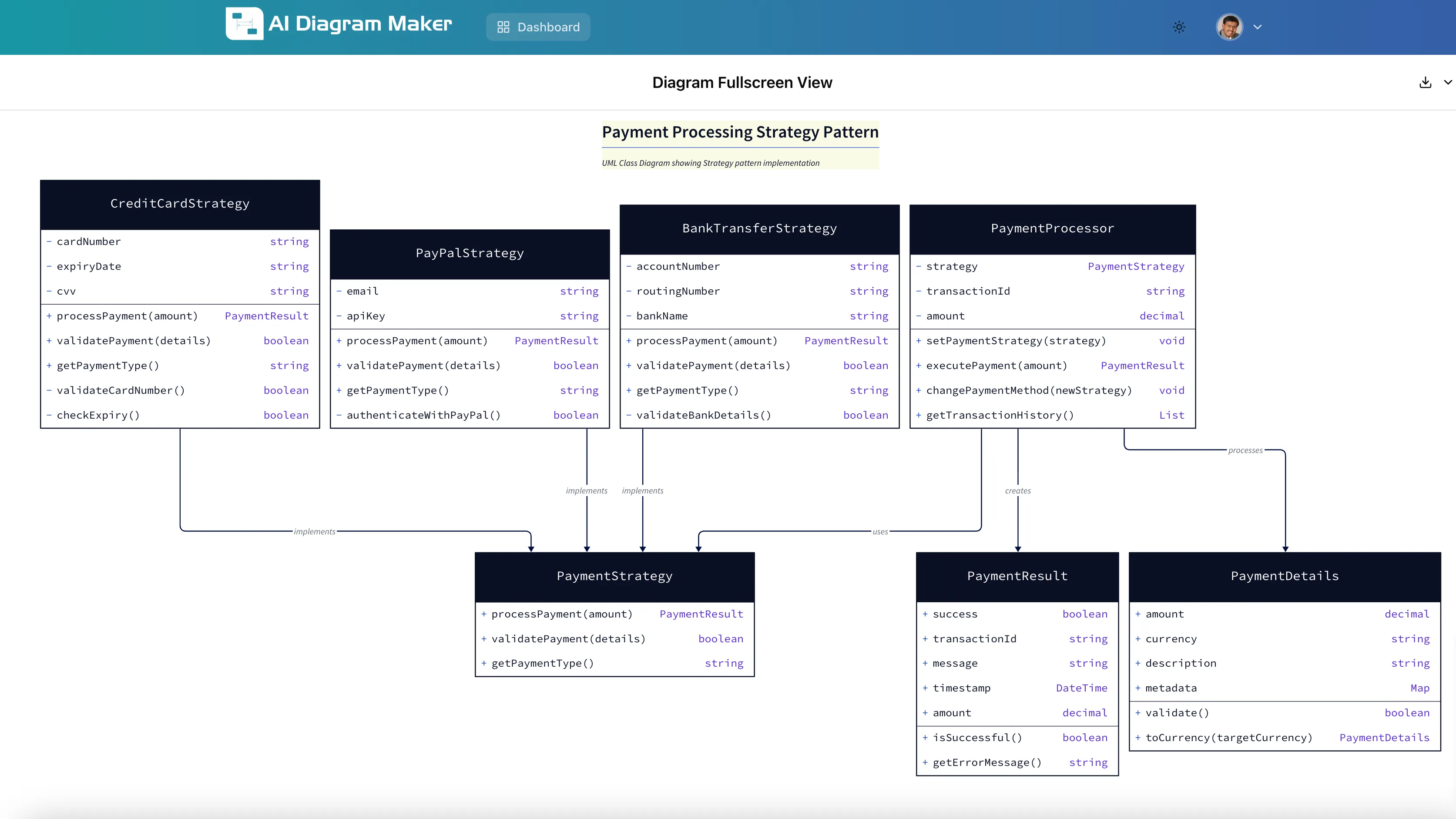
Result: A complete UML class diagram with:
- PaymentStrategy interface with core payment methods
- Three concrete implementations (CreditCardStrategy, PayPalStrategy, BankTransferStrategy)
- PaymentProcessor context class managing strategy execution
- Proper UML notation showing inheritance and composition relationships
This workflow is ideal when you’re exploring design patterns and want AI to handle the implementation details.
Example 2: Detailed Specifications to UML Diagram
When you already know exactly what classes and methods you need, you can provide complete specifications upfront and get an immediate diagram.
Input: Comprehensive class definitions with attributes and methods
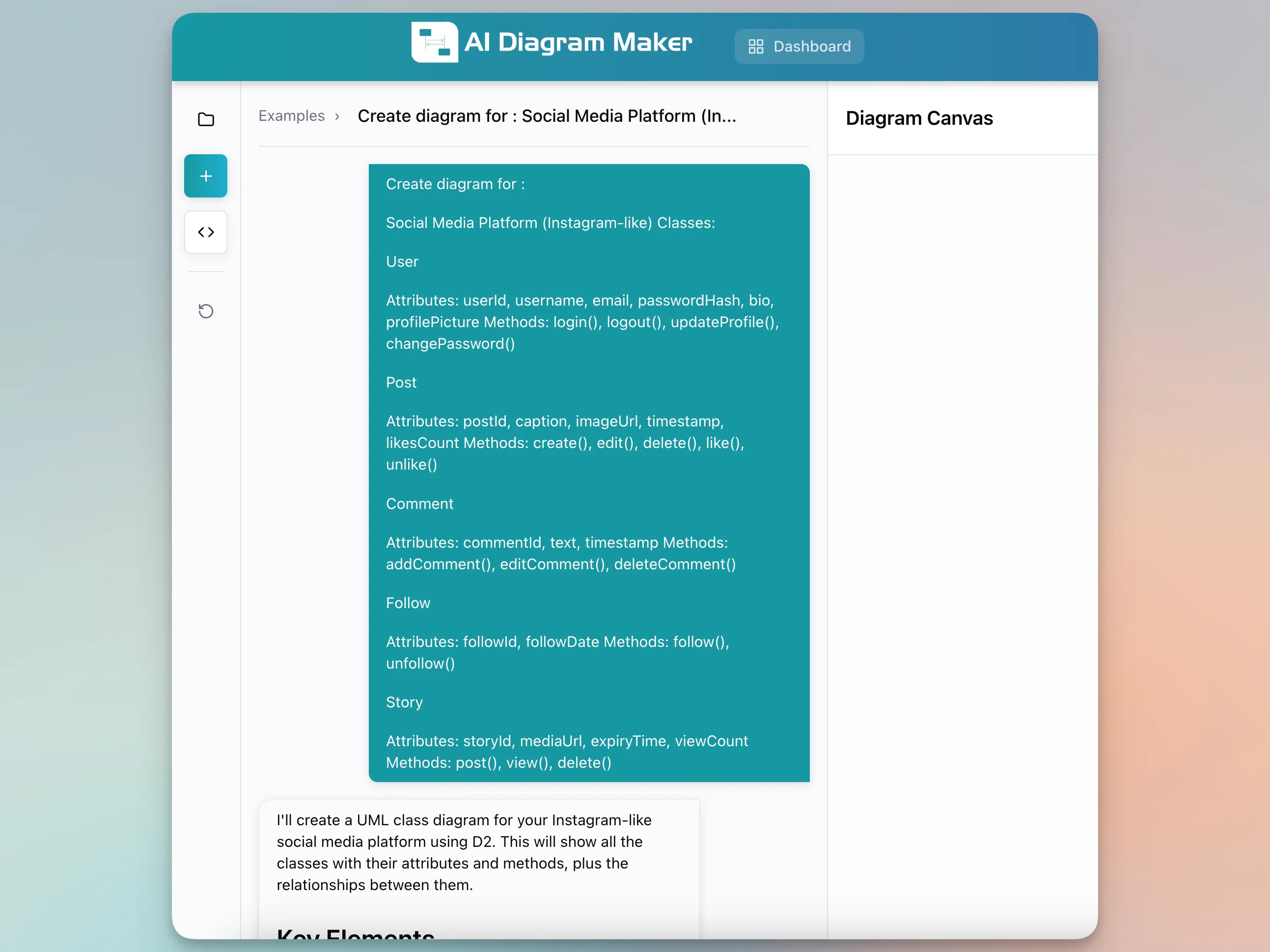
The user provided detailed specifications for a social media platform (Instagram-like)
The AI analyzed this structured input and immediately generated:
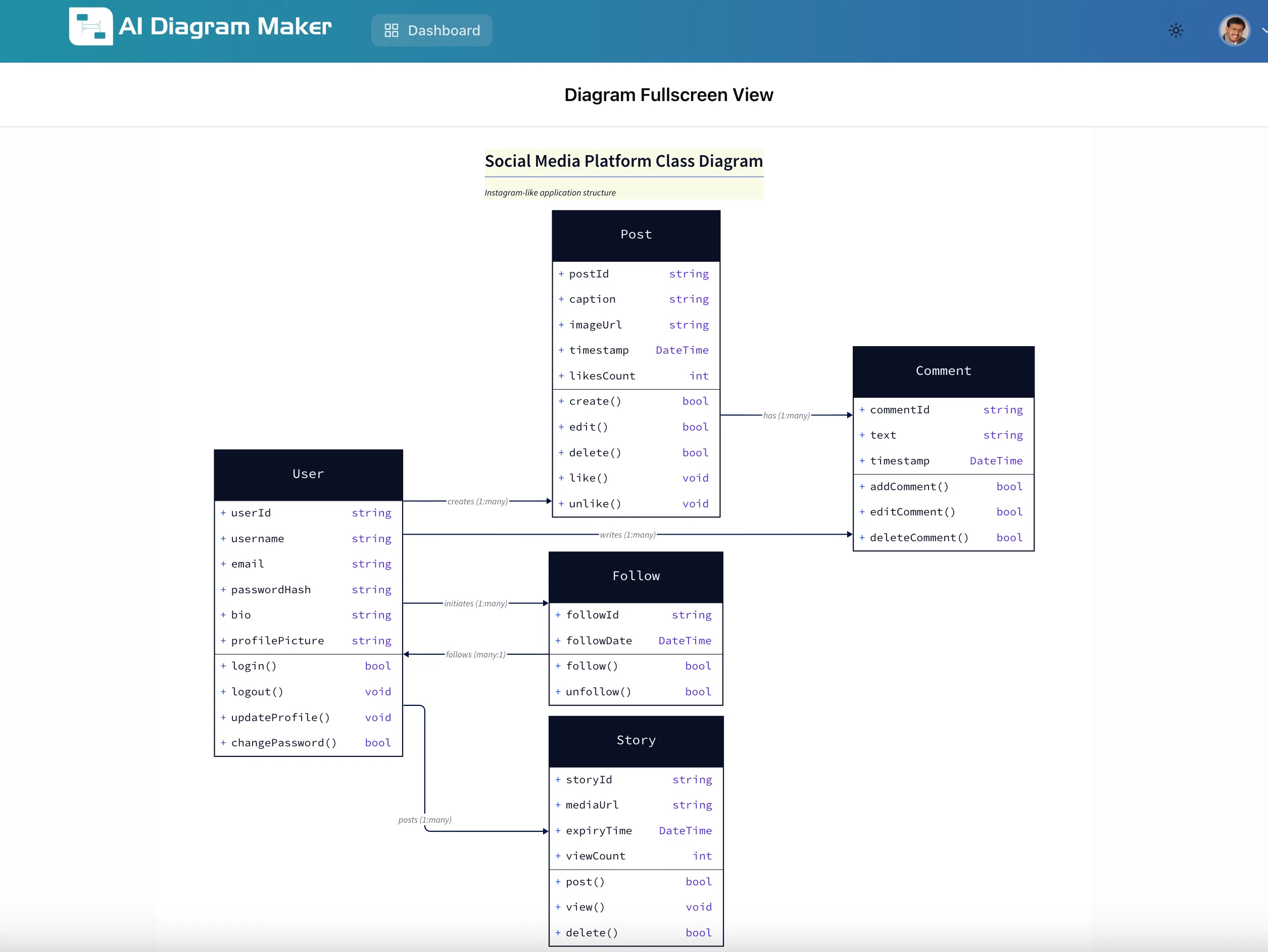
Result: A complete UML class diagram that accurately represents all specified requirements. The AI correctly:
- Generated 5 classes with correct UML structure
- Added attributes, methods with proper data types and signatures
- Identified relationships (composition, association, self-association) with proper UML notation
This approach is perfect when you’ve already planned your class structure and just need quick visualization without manually drawing boxes and arrows.
Example 3: Reverse Engineering Code to UML
One of the most powerful features is the ability to reverse engineer existing source code, ensuring your documentation stays synchronized with your actual implementation.
Input: Python class definitions with inheritance hierarchy
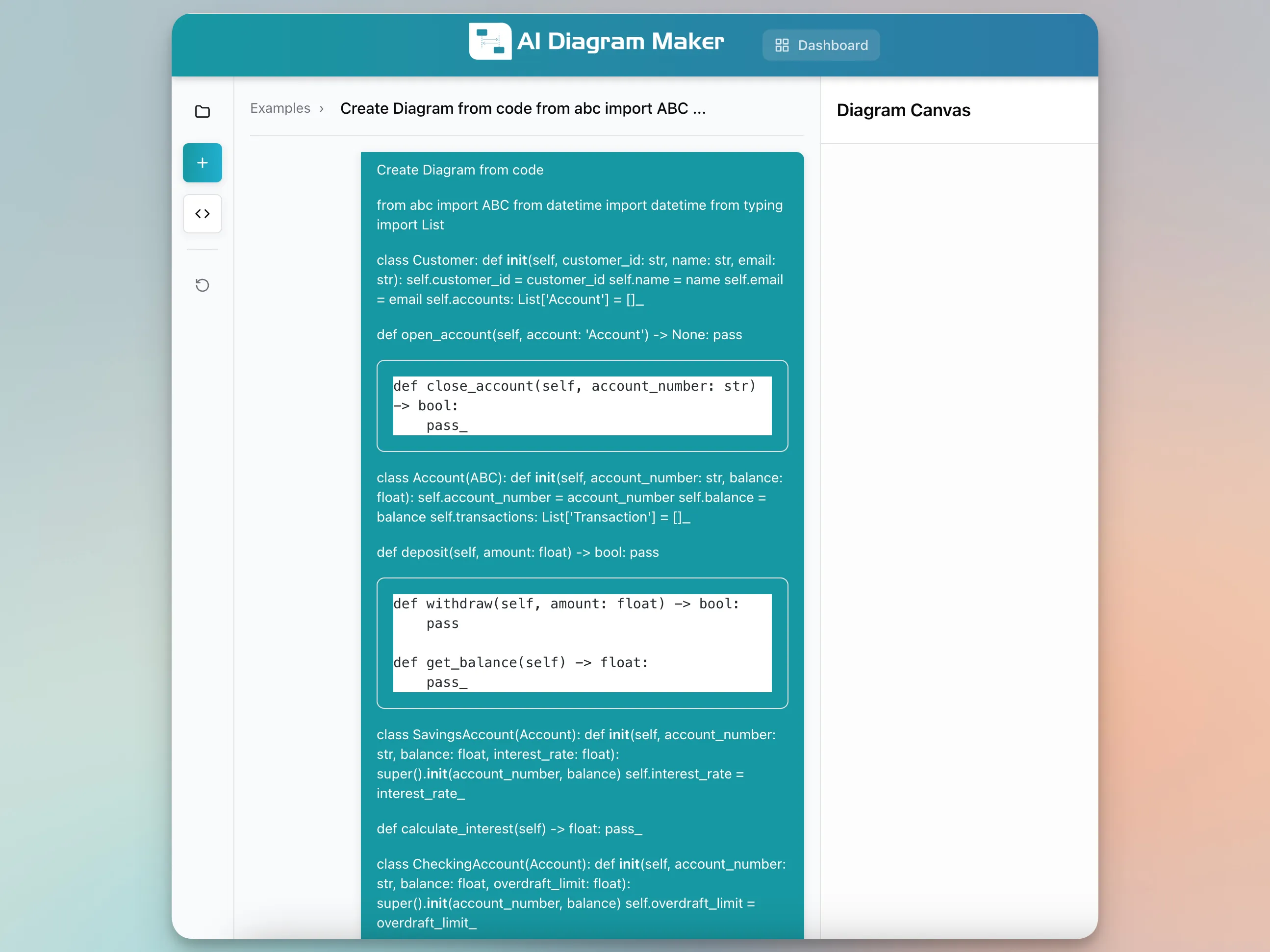
The user provided complete Python class definitions for a banking system, including:
from abc import import ABC
from datetime import import datetime
from typing import List
class Customer:
def __init__(self, customer_id: str, name: str, email: str):
self.customer_id = customer_id
self.name = name
self.email = email
self.accounts: List['Account'] = []
def open_account(self, account: 'Account') -> None:
pass
def close_account(self, account_number: str) -> bool:
pass
class Account(ABC):
def __init__(self, account_number: str, balance: float):
self.account_number = account_number
self.balance = balance
self.transactions: List['Transaction'] = []
def deposit(self, amount: float) -> bool:
pass
def withdraw(self, amount: float) -> bool:
pass
def get_balance(self) -> float:
pass
class SavingsAccount(Account):
def __init__(self, account_number: str, balance: float, interest_rate: float):
super().__init__(account_number, balance)
self.interest_rate = interest_rate
def calculate_interest(self) -> float:
pass
#remaining classes The AI parsed the Python code, extracted all class definitions, identified the inheritance hierarchy (SavingsAccount and CheckingAccount inherit from Account), recognized the composition relationships (Customer has Accounts, Account has Transactions), and generated:
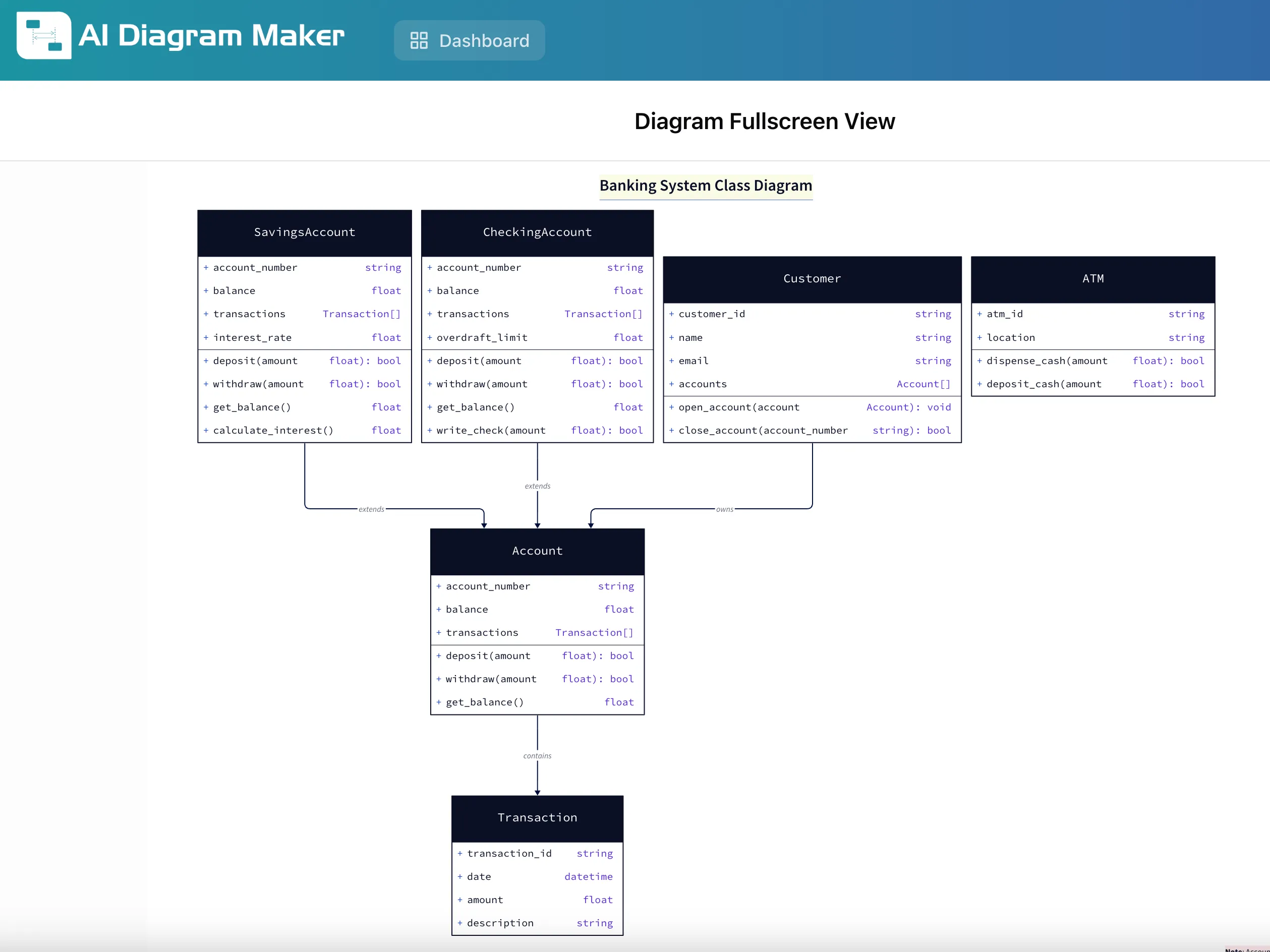
Result: An accurate UML class diagram that perfectly represents the code structure with:
- Correct class structure with attributes and methods
- Inheritance hierarchy showing SavingsAccount and CheckingAccount extending Account
- Composition relationships showing Customer has multiple Accounts and Account has multiple Transactions
- Clean layout with abstract Account class centrally positioned and subclasses below it
Why Reverse Engineering Matters:
- Documentation sync: Automatically update diagrams when code changes
- Legacy systems: Quickly visualize complex existing codebases
- Refactoring support: See the impact of structural changes before implementing
This capability is essential for maintaining accurate documentation throughout the development lifecycle.
Step-by-Step: Using an AI UML Diagram Generator
1. Choose Your Input Method
Decide which approach fits your workflow:
- High-level prompt: Describe design patterns or system concepts in simple terms
- Detailed specifications: Provide complete class, attribute, and method definitions
- Source code: Paste existing class implementations for reverse engineering
2. Generate Your UML Diagram
- Go to AIDiagramMaker
- Select “Create new diagram”
- Provide your input (text or code)
- AI analyzes and generates the UML diagram in 30-60 seconds
3. Review and Refine
The initial output typically captures 90%+ of your requirements. You can:
- Ask AI to add missing classes or methods
- Adjust relationships or inheritance hierarchies
- Request specific design pattern implementations
- Export to various formats (PNG, SVG, diagram-as-code)
Best Practices for AI UML Generation
For Text-Based Input (Text to Diagram)
- Be specific about relationships: Clearly state “inherits from,” “has-a,” “uses,” or “implements”
- Include method signatures: Mention parameters and return types when known
- Specify design patterns: Reference patterns by name (Strategy, Factory, Observer, etc.)
For Source Code Input (Code to Diagram)
- Use clear naming conventions: Well-named classes and methods improve diagram readability
- Add code comments: Comments help AI understand intent and relationships
- Provide related classes: Include all classes that interact for accurate relationship mapping
- Include complete class definitions: Provide full class structures including attributes, methods, and inheritance hierarchies
Comparison: Manual vs. AI UML Creation
| Aspect | Manual UML Tools | AI UML Generator |
|---|---|---|
| Time Investment | 1-3 hours per diagram | 30-60 seconds |
| Skill Requirement | UML notation + design expertise | Basic requirements description |
| Reverse Engineering | Manual code inspection + drawing | Automatic from source code |
| Updates | Manual edits | Regenerate from updated code |
| Consistency | Varies by creator | Standardized UML notation |
| Design Pattern Support | Manual implementation | AI suggests best practices |
Conclusion
AI-powered UML generation transforms software design documentation from a time-consuming chore into a quick, automated process. Whether you’re designing new systems from high-level concepts, reverse engineering existing code, or maintaining documentation, these tools eliminate the friction between software design and documentation, ensuring diagrams stay current throughout the development lifecycle.
FAQ
What is an AI UML diagram generator?
A tool that uses artificial intelligence to automatically create UML (Unified Modeling Language) class diagrams from text descriptions or source code. It eliminates manual drawing by understanding software structure, relationships, and design patterns.
Can I generate UML diagrams from existing source code?
Yes, these tools can reverse engineer source code into diagrams. Simply paste your class definitions (Python, Java, C++, C#, TypeScript, etc.), and the AI will generate an accurate UML diagram showing all classes, attributes, methods, and relationships including inheritance and composition.
What input formats are supported?
Most tools support:
- Text descriptions (high-level or detailed specifications)
- Source code (class definitions in multiple programming languages)
- Natural language prompts describing design patterns or system architectures
How accurate are AI-generated UML diagrams?
Accuracy depends on input quality. Well-structured source code produces 95%+ accurate diagrams with correct inheritance hierarchies and relationships. Text descriptions work best when you specify classes, methods, and relationships clearly.
Can I use this for design patterns?
Absolutely. These tools excel at implementing design patterns. Simply mention the pattern name (Strategy, Factory, Observer, Singleton, etc.) and the AI will generate a complete UML diagram showing the proper implementation with all necessary classes and relationships.
What programming languages are supported for reverse engineering?
Most tools support popular object-oriented languages including Python, Java, C++, C#, TypeScript, JavaScript, Ruby, PHP, Go, and Kotlin. The AI can parse class definitions, inheritance hierarchies, and method signatures from these languages.
How does this compare to traditional UML tools?
AI-powered tools are significantly faster (seconds vs. hours) and don’t require manual drawing. They excel at reverse engineering code. Traditional tools offer more granular control but require more time and UML expertise. AI tools are ideal for rapid prototyping and maintaining synchronized documentation.
Can I edit the generated diagrams?
Yes, you can refine diagrams by providing additional instructions to the AI or by exporting to traditional diagramming tools. Most tools allow iterative refinement through natural language commands like “add a Factory class” or “show composition relationship between X and Y.”
